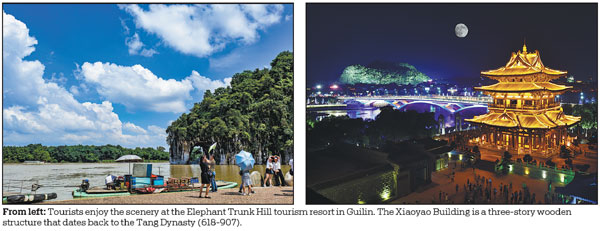October a boon for tourism and development in region
The month of October is packed full of tourism festivals and events in Guilin, a popular international destination in China's Guangxi Zhuang autonomous region.
The city hosts the 13th UNWTO/PATA Forum on Tourism Trends and Outlook, the 2019 China-ASEAN Expo Tourism Exhibition, the ninth Guilin International Landscape Culture & Tourism Festival, and the fifth Joint Conference of High-Speed Railway Economic Belt of Guangdong, Guangxi, Guizhou and Yunnan from Oct 17 to 19.
These activities have earned Guilin plenty attention from home and abroad, and are important platforms for the city to promote tourism exchanges and regional cooperation. They help Guilin show its achievements in integrated development and the city will draw inspiration from the events to further advance its integrated development strategies.
Guilin covers an area of 27,800 square kilometers - 71 percent of its land is covered by forest - with a population of 5.4 million. The city boasts picturesque landscapes featuring karst and Danxia landforms, and has four world heritage of karst scenes of the Lijiang River. They include the Bajiao village in Ziyuan, the Lingqu Canal of Xing'an, the Longji Terrace and the Lijiang River, which flows across Guilin before joining the Pearl River. It was selected as one of the most beautiful 15 rivers in the world.
Apart from its picturesque landscape, Guilin also boasts rich cultural tourism resources that stem from its long history, highlighted by the Zengpiyan ruins dating back to 7,000 to 12,000 years ago. Guilin's cultural charms come from the Lingqu Canal of the Qin Dynasty (221-207 BC), Guihai inscriptions on precipices and the Xiangjiang River Battle ruins left by the Red Army in its heroic Long March in the 1930s, and its minority ethnic culture.
Guilin has received visits by more than 180 delegations of foreign leaders and senior officials since its opening-up in 1973.
The city has 14 universities, nine institutions directly affiliated to the Guangxi government and 43 key laboratories, as well as 235 innovation platforms and bases. The city was also earmarked by the State Council as a place to build a national tourism demonstration base, a national sustainable development innovation demonstration zone, and international tourism destination, which means it assumes an increasingly important role in national and regional tourism and innovative development.
The State Council, China's Cabinet, approved the plan of constructing and developing Guilin into an international tourism destination on Nov 11, 2012, meaning that the city's local planning had been upgraded into a national strategy, providing Guilin with golden opportunities to boost its tourism industry.
According to the plan, Guilin will strive to become a first-class tourist destination in the world, a national ecological civilization construction demonstration zone, a national pilot zone for innovative development of tourism, a regional cultural tourism center and an important platform for international tourism exchanges.
Through about seven years' hard work, the city has made concrete progress in these respects, continuously serving as a good example for the improvement and transformation of China's tourism industry.
Guilin was one of the first cities in the Chinese mainland to implement a 72-hour visa-free transit stay policy for tourists from 51 countries, including the United States, Germany and the United Kingdom. It also offers a six-day visa-free stay policy for tourists from all 10 member countries of the Association of Southeast Asian Nations, and has piloted a national tourism land use reform.
The fast rise of Guilin's tourism is partially based on the marked development of its transport infrastructure. Not only is the city a regional hub of airlines and highways, but also a crossroads for high-speed rail.
The high-speed railway connecting Hunan and Guangxi and the high-speed railway connecting Guangdong and Guizhou cross at Guilin.
Guilin will also build a cooperative pilot zone, which is expected to promote the commercialization and industrialization of the production factors and resources that flow along the high-speed railway into the city's economic belt.
It takes about 150 minutes to reach Guangzhou, capital of Guangdong province and about 120 minutes to reach Guiyang, capital of Guizhou province from Guilin via high-speed railway. It also takes about four hours to travel to Kunming, capital of Yunnan province.

